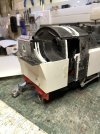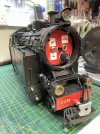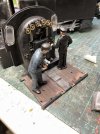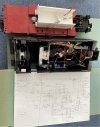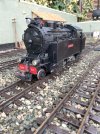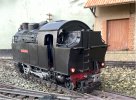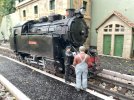viaEstrecha
Spanish metre gauge in G scale (on the cheap)
The Škoda Saga Part 1/3.
Once upon a time, the forum had several accounts of tinkering with the Newquida thing, so indulge me whilst I add my own, if a decade late to the party. This loco was not supposed to happen, and at one point, it almost didn't, but an unexpected glitch with the supply of components somehow saw me add an extra Fosworks order and my other works in progress stalled briefly and so I embarked on my journey of wonder...
I had always assumed my old and evidently very well-used Newquida LGB 2080 knock-off (obtained for just a few pounds) would consume any parts I had left over from previously converted locos and retain its original radio control, and would then be ideal for my grandson to run as 'his' loco, now that he is 7 and very responsible. No matter that it was out of place on a Spanish themed railway. Then I had one of those silly late night moments of inspiration and a change of plan. It might seem daft, to put in a full conversion on such a tacky model, but I found an authentic-ish prototype, worked out how to butcher the body and reckoned I could justify it, and perhaps replace the motor and motion etc with a proper LGB one, should a donor loco ever turn up at a decent secondhand price. All I would need to do then is put in a larger battery pack and possibly even put in a smoke unit for occasional amusement.
The historical facts and fiction:
In 1942, the Ferrocarril de La Robla (FR) obtained three enormous Škoda 141T locomotives of 1924 vintage from a Portugese mining company (nos 90-92, each subtly different), but it is little known that a fourth, slightly smaller, sister loco, with wheel arrangement 131T, was also at the same time purchased by the Ferrocarril Val de Martyn (FVM). Voila, another Spanish lookalike with plausible backstory was born - with half a dozen photos from the internet to go from, I could tweak the Newquida to look similar to those Škodas, albeit slightly shorter, with a fully-faired cylinder block and one pair of driving wheels and third dome missing, all of which is a still good enough compromise for my forgiving eye. And it would be consistent with my other locos and so could use the same Fosworks Tx handsets and charger. Here's the real thing:
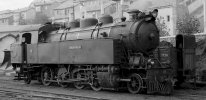
And my tribute model:
[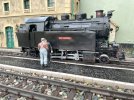
The journey:
The Newquida 2-6-2T was completely disassembled and all electrics bar the motor discarded. The body shell has only 4 or 5 main parts and is initially huge inside, so I could fit all the leccy bits in easily in the domes and side tanks, including allowing for a potentially larger battery pack in future, sat on a platform over the motor block. Taking a razor saw and Dremel to this body was a more relaxing proposition than the big Henschel diesel rebuild will be, later down the line, but I do need more practice before I attempt that magnum opus. The main modification was to hack about 18mm from the centre of the cab to make it shorter, which would need new plasticard overlays to the sides, with a single opening, to replace the original Krupp windows and doors. Painful - now I understand why 3D printing has become so popular. Only the forward- and rear-facing windows retained glazing.
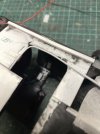
At the front, the running plate and buffer beam arrangement required making narrower and taller, with some cosmetic detailing and Slaters embossed lettering. A homemade front cowcatcher was produced, using ABS rod and styrene profile - fiddly but essential to make the loco recognisably Škoda-like, if a touch reduced to permit garden railway use over tight curves.
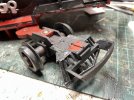
The side tanks were also made a little taller, with a sloping top at the fronts. Again, thin plasticard overlays disguised the originals, with the tank filler caps re-used. At the rear, the bunker was made much longer and small alterations were required to the shape and details, to give it that Škoda profile. I recycled by modification, most of the extra parts from the Newquida. New side steps, pipework and tanks were put under the cab, a lot of raiding of the bits box was done to represent external equipment, including rear bunker ladder and lamps and some pipework/handrails were added to compensate for ditching most of the Newquida's boiler-top detailing.
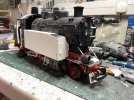
Once upon a time, the forum had several accounts of tinkering with the Newquida thing, so indulge me whilst I add my own, if a decade late to the party. This loco was not supposed to happen, and at one point, it almost didn't, but an unexpected glitch with the supply of components somehow saw me add an extra Fosworks order and my other works in progress stalled briefly and so I embarked on my journey of wonder...
I had always assumed my old and evidently very well-used Newquida LGB 2080 knock-off (obtained for just a few pounds) would consume any parts I had left over from previously converted locos and retain its original radio control, and would then be ideal for my grandson to run as 'his' loco, now that he is 7 and very responsible. No matter that it was out of place on a Spanish themed railway. Then I had one of those silly late night moments of inspiration and a change of plan. It might seem daft, to put in a full conversion on such a tacky model, but I found an authentic-ish prototype, worked out how to butcher the body and reckoned I could justify it, and perhaps replace the motor and motion etc with a proper LGB one, should a donor loco ever turn up at a decent secondhand price. All I would need to do then is put in a larger battery pack and possibly even put in a smoke unit for occasional amusement.
The historical facts and fiction:
In 1942, the Ferrocarril de La Robla (FR) obtained three enormous Škoda 141T locomotives of 1924 vintage from a Portugese mining company (nos 90-92, each subtly different), but it is little known that a fourth, slightly smaller, sister loco, with wheel arrangement 131T, was also at the same time purchased by the Ferrocarril Val de Martyn (FVM). Voila, another Spanish lookalike with plausible backstory was born - with half a dozen photos from the internet to go from, I could tweak the Newquida to look similar to those Škodas, albeit slightly shorter, with a fully-faired cylinder block and one pair of driving wheels and third dome missing, all of which is a still good enough compromise for my forgiving eye. And it would be consistent with my other locos and so could use the same Fosworks Tx handsets and charger. Here's the real thing:

And my tribute model:
[

The journey:
The Newquida 2-6-2T was completely disassembled and all electrics bar the motor discarded. The body shell has only 4 or 5 main parts and is initially huge inside, so I could fit all the leccy bits in easily in the domes and side tanks, including allowing for a potentially larger battery pack in future, sat on a platform over the motor block. Taking a razor saw and Dremel to this body was a more relaxing proposition than the big Henschel diesel rebuild will be, later down the line, but I do need more practice before I attempt that magnum opus. The main modification was to hack about 18mm from the centre of the cab to make it shorter, which would need new plasticard overlays to the sides, with a single opening, to replace the original Krupp windows and doors. Painful - now I understand why 3D printing has become so popular. Only the forward- and rear-facing windows retained glazing.

At the front, the running plate and buffer beam arrangement required making narrower and taller, with some cosmetic detailing and Slaters embossed lettering. A homemade front cowcatcher was produced, using ABS rod and styrene profile - fiddly but essential to make the loco recognisably Škoda-like, if a touch reduced to permit garden railway use over tight curves.

The side tanks were also made a little taller, with a sloping top at the fronts. Again, thin plasticard overlays disguised the originals, with the tank filler caps re-used. At the rear, the bunker was made much longer and small alterations were required to the shape and details, to give it that Škoda profile. I recycled by modification, most of the extra parts from the Newquida. New side steps, pipework and tanks were put under the cab, a lot of raiding of the bits box was done to represent external equipment, including rear bunker ladder and lamps and some pipework/handrails were added to compensate for ditching most of the Newquida's boiler-top detailing.


